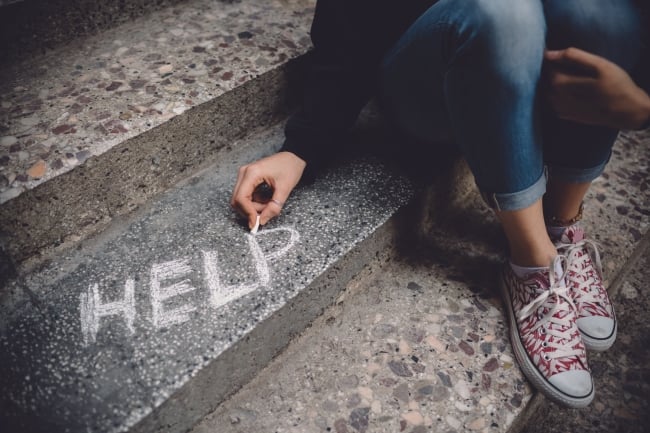You have /5 articles left.
Sign up for a free account or log in.

In the Student Voice survey on health and wellness, awareness of where to go on campus in case of a mental health crisis is lowest for students who rate their own mental health as poor.
Nico El Nino/iStock/Getty Images Plus
“It’s widespread, it’s frequent and it’s big, because they have to see it at the point they need. Otherwise they’ll forget it.”
That’s how Angela M. Stowe, director of student counseling services at the University of Alabama at Birmingham, responds to a question with no easy answer: How do you make sure that every student on campus gets the message about where to go if they or a friend are experiencing a mental health crisis?
“Our experience is, you do all things for all people,” continues Stowe, who also heads UAB Cares, the university’s suicide-prevention initiative. “Everybody at once in a different way. We blast it out as many ways as we can, through as many channels and people that we can.”
Just 2 in 3 Students Know Where to Go
In the recent health and wellness–centered Student Voice survey, just two-thirds of students (66 percent) strongly or somewhat agree that they know where to seek help on campus if they or a friend are experiencing a mental health crisis. That means a third of the survey’s 3,000 respondents at 158 two- and four-year institutions are either neutral on the subject or disagree, somewhat or strongly, that they know where to find help.
With big implications for campus mental health awareness efforts, the awareness rate relative to how students rate their own mental health is lowest—57 percent—for students who say their mental health is poor (n=477) instead of fair, good or excellent. Students who rate their mental health as poor are also most likely to strongly disagree that they know where to go on campus is case of a mental health emergency (19 percent).
The awareness rate is highest, meanwhile—73 percent—for students who rate their mental health as excellent (n=438).
Crisis resources awareness levels are relatively consistent across a variety of other student and institutional characteristics, with a few exceptions that point to possible areas for targeted interventions:
- By race, 70 percent of white students say they know where to go in case of a mental health crisis, compared to 62 percent of Black students. (Asian and Hispanic students’ awareness rates fall at the two-thirds average.)
- Three in four varsity athletes know where to go, suggesting that sports teams may be effective structures for delivering vital information about mental health resources.
- Community college students also report lower levels of awareness, at 61 percent, relative to 66 percent of four-year college students. And just 55 percent of community college students who rate their mental health as poor or fair, in particular, say they know where to go in case of a mental health crisis.
- First-generation students have a 61 percent awareness rate, compared to 68 percent of continuing generations. And first-generation students at community colleges have especially low awareness, 56 percent.
Stowe of the University of Alabama at Birmingham advocates a multimodal, saturation-based approach to building and increasing this kind of knowledge across an institution. But what does that look like in practice, especially on a campus such as hers, with 13,000 undergraduates alone?
Faculty messengers: First, Stowe relies heavily on faculty and staff members to get the word out, as students on her campus consistently report that these employees are the No. 1 way they find out about mental health services.
To educate faculty and staff advocates, the university’s Center for Teaching and Learning offers a training series called Mental Health Matters. Topics include foundations in collegiate mental health, how and when to have conversations with students of concern, suicide prevention gatekeeper training, and mental health first aid for higher education. The university’s website and learning management system also include information for faculty and staff members on supporting mental health, including students in crisis.
In addition, students, faculty and staff members may use an online, simulation-based platform to learn to identify signs of concern and have conversations about mental health. This helps free up therapists for additional counseling appointments and outreach.
Student outreach: For direct student outreach, Stowe and her team “use all the ways,” meaning fliers, social media, emails. Weekly tabling events across campus are key, so that students are repeatedly reminded of what’s available—especially during high-stress periods like midterms and finals.
Stowe reiterates, “Obviously, like everybody, we show up at orientations and places like that, where students learn about what’s available on campus. But the challenge is, people don’t look for mental health services until they need them.”
Badges and an app: Trying to find a way to promote mental health through technology during the pandemic, the university also created its own mental health app called UABwell. Students and employees alike can access immediate crisis help by clicking a button. Users may also schedule mental health care appointments, create self-care plans, track daily habits and access relaxation, yoga and mindfulness videos and affirmations and more. There is a calendar of upcoming mental health events, too.
Because the app was specifically designed for user privacy, Stowe doesn’t know who is using it. But she does know it’s been downloaded nearly 6,000 times.
“It really is a hub of all of our mental health resources in one place,” she adds.
Additionally, the university offers mental health advocate badging for faculty and staff members, as well as students. Stowe says the badging goal for students, in particular, who are able to become mental health “fellows,” is to create “a culture of care and taking care of each other” and otherwise promote a “culture that supports mental health.”
Crisis Response
The suicide-prevention initiative that Stowe leads, UAB Cares, includes crisis resources and response information for students and employees, the gatekeeper training, and signage all over campus, including in parking garages. A food pantry called Blazer Kitchen is also associated with UAB Cares.
Stowe says the suicide-prevention initiative began five years ago with a charge from campus leaders to develop a “comprehensive, collaborative and coordinated” prevention strategy.
In addition to accessing emergency care via the UABwell app and other means, students in crisis can walk into counseling offices for immediate assistance.
“We have been able to see the students that we’ve known about the same day or when they need to be seen, and we’ve been able to do that because we’re linked with other people across campus that are well trained,” Stowe says. “So it’s a team effort.”
Multiple Pathways to Care
Brett Scofield, executive director of the Center for Collegiate Mental Health and associate director of the Center for Counseling and Psychological Services at Pennsylvania State University, agrees that it’s important for colleges and universities to “offer multiple pathways for students to access professional crisis services, including in-person urgent care from the counseling center, crisis lines, text-based services and local first responders and hospitals.” Third-party teletherapy vendors are now commonly provide phone- and text-based crisis care, he notes.
On building awareness, Scofield also recommends the Red Folder Initiative, which was developed at Penn State to help guide faculty and staff members, student leaders and others to recognize, respond and refer students in various levels of distress: high, moderate and low. (UAB includes the Red Folder Initiative in its awareness efforts.)
The Jed Foundation urges colleges to “have everyone on campus educated on how to recognize signs of struggle, know how to reach out and know when and where to refer to professional help if or when needed,” says Nance Roy, chief clinical officer at the organization and assistant clinical professor of psychiatry at Yale University.
This kind of training and education shouldn’t be “one-and-done,” either, Roy adds, but rather ongoing, with refreshers offered at least annually.
What are the fundamentals of campus crisis care? Roy says counseling center walk-in availability and/or phone triage with access to after-hours counseling and support—either through college staff on call or a contracted outside provider—are essential.
And while not as personalized, she notes that crisis text lines, in addition to 988, the national Suicide and Crisis Lifeline, should also be advertised.
What works on your campus for boosting mental health crisis resource awareness? Tell us here.




